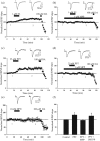Activation of oestrogen receptor α induces a novel form of LTP at hippocampal temporoammonic-CA1 synapses
- PMID: 31637699
- PMCID: PMC7012968
- DOI: 10.1111/bph.14880
Activation of oestrogen receptor α induces a novel form of LTP at hippocampal temporoammonic-CA1 synapses
Abstract
Background and purpose: 17β estradiol (E2) rapidly regulates excitatory synaptic transmission at the classical Schaffer collateral (SC) input to hippocampal CA1 neurons. However, the impact of E2 on excitatory synaptic transmission at the distinct temporoammonic (TA) input to CA1 neurons and the oestrogen receptors involved is less clear.
Experimental approach: Extracellular recordings were used to monitor excitatory synaptic transmission in hippocampal slices from juvenile male (P11-24) Sprague Dawley rats. Immunocytochemistry combined with confocal microscopy was used to monitor the surface expression of the AMPA receptor (AMPAR) subunit, GluA1 in hippocampal neurons cultured from neonatal (P0-3) rats.
Key results: Here, we show that E2 induces a novel form of LTP at TA-CA1 synapses, an effect mirrored by the ERα agonist, PPT, and blocked by an ERα antagonist. ERα-induced LTP is NMDA receptor (NMDAR)-dependent and involves a postsynaptic expression mechanism that requires PI 3-kinase signalling and synaptic insertion of GluA2-lacking AMPARs. ERα-induced LTP has overlapping expression mechanisms with classical Hebbian LTP, as HFS-induced LTP occluded PPT-induced LTP and vice versa. In addition, activity-dependent LTP was blocked by the ERα antagonist, suggesting that ERα activation is involved in NMDA-LTP at TA-CA1 synapses.
Conclusion and implications: ERα induces a novel form of LTP at juvenile male hippocampal TA-CA1 synapses. As TA-CA1 synapses are implicated in episodic memory processes and are an early target for neurodegeneration, these findings have important implications for the role of oestrogens in CNS health and neurodegenerative disease.
© 2019 The British Pharmacological Society.
Conflict of interest statement
The authors declare no conflicts of interest.
Figures






References
-
- Aksoy‐Aksel, A. , & Manahan‐Vaughan, D. (2015). Synaptic strength at the temporoammonic input to the hippocampal CA1 region in vivo is regulated by NMDA receptors, metabotropic glutamate receptors and voltage‐gated calcium channels. Neuroscience, 309, 191–199. 10.1016/j.neuroscience.2015.03.014 - DOI - PubMed
-
- Alexander, S. P. H. , Roberts, R. E. , Broughton, B. R. S. , Sobey, C. G. , George, C. H. , Stanford, S. C. , … Ahluwalia, A. (2018). Goals and practicalities of immunoblotting and immunohistochemistry: A guide for submission to the British Journal of Pharmacology. British Journal of Pharmacology, 175, 407–411. 10.1111/bph.14112 - DOI - PMC - PubMed
Publication types
MeSH terms
Substances
Grants and funding
LinkOut - more resources
Full Text Sources
Medical
Research Materials
Miscellaneous

